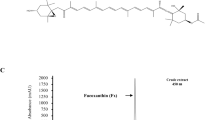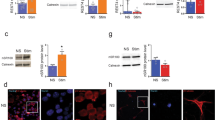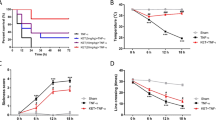Abstract
Proinflammatory cytokines and serotonergic homeostasis have both been implicated in the pathophysiology of major psychiatric disorders. We have demonstrated that activation of p38 mitogen-activated protein kinase (MAPK) induces a catalytic activation of the serotonin transporter (SERT) arising from a reduction in the SERT Km for 5-hydroxytryptamine (5-HT). As inflammatory cytokines can activate p38 MAPK, we hypothesized that they might also activate neuronal SERT. Indeed, Interleukin-1beta (IL-1β) and tumor necrosis factor alpha (TNF-α) stimulated serotonin uptake in both the rat embryonic raphe cell line, RN46A, and in mouse midbrain and striatal synaptosomes. In RN46A cells, IL-1β stimulated 5-HT uptake in a dose- and time-dependent manner, peaking in 20 min at 100 ng/ml. This was abolished by IL-1ra (20 ng/ml), an antagonist of the IL-1 receptor, and by SB203580 (5 μM), a p38 MAPK inhibitor. TNF-α also dose- and time-dependently stimulated 5-HT uptake that was only partially blocked by SB203580. Western blots showed that IL-1β and TNF-α activated p38 MAPK, in an SB203580-sensitive manner. IL-1β induced an SB203580-sensitive decrease in 5-HT Km with no significant change in Vmax. In contrast, TNF-α stimulation decreased 5-HT Km and increased SERT Vmax. SB203580 selectively blocked the TNF-α-induced change in SERT Km. In mouse midbrain and striatal synaptosomes, maximal stimulatory effects on 5-HT uptake occurred at lower concentrations (IL-1β, 10 ng/ml; TNF-α, 20 ng/ml), and over shorter incubation times (10 min). As with RN46A cells, the effects of IL-1β and TNF-α were completely (IL-1β) or partially (TNF-α) blocked by SB203580. These results provide the first evidence that proinflammatory cytokines can acutely regulate neuronal SERT activity via p38 MAPK-linked pathways.
Similar content being viewed by others
Log in or create a free account to read this content
Gain free access to this article, as well as selected content from this journal and more on nature.com
or
References
Ansah TA, Ramamoorthy S, Montanez S, Daws LC, Blakely RD (2003). Ca2+-dependent inhibition of synaptosomal serotonin transport by the alpha 2-adrenoceptor agonist 5-bromo-N-[4,5-dihydro-1H-imidazol-2-yl]-6-quinoxalinamine (UK14304). J Pharmacol Exp Ther 305: 956–965.
Ban E, Milon G, Prudhomme N, Fillion G, Haour F (1991). Receptors for interleukin-1 (alpha and beta) in mouse brain: mapping and neuronal localization in hippocampus. Neuroscience 43: 21–30.
Barker EL, Blakely RD (1995). Norepinephrine and serotonin transporters: molecular targets of antidepressant drugs. In: Bloom FE, Kupfer DJ (eds). Psychopharmacology: The Fourth Generation of Progress. Raven Press, Ltd: New York. pp 321–333.
Bette M, Kaut O, Schafer MK, Weihe E (2003). Constitutive expression of p55TNFR mRNA and mitogen-specific up-regulation of TNF alpha and p75TNFR mRNA in mouse brain. J Comp Neurol 465: 417–430.
Blakely RD, Defelice LJ, Galli A (2005). Biogenic amine neurotransmitter transporters: just when you thought you knew them. Physiology (Bethesda) 20: 225–231.
Botchkina GI, Meistrell Jr ME, Botchkina IL, Tracey KJ (1997). Expression of TNF and TNF receptors (p55 and p75) in the rat brain after focal cerebral ischemia. Mol Med 3: 765–781.
Breder CD, Dinarello CA, Saper CB (1988). Interleukin-1 immunoreactive innervation of the human hypothalamus. Science 240: 321–324.
Breder CD, Tsujimoto M, Terano Y, Scott DW, Saper CB (1993). Distribution and characterization of tumor necrosis factor-alpha-like immunoreactivity in the murine central nervous system. J Comp Neurol 337: 543–567.
Brockhaus M, Loetscher H (1990). Identification of two types of TNF receptors on human cell line by monoclonal antibodies. Proc Natl Acad Sci USA 87: 3127.
Caspi A, Sugden K, Moffitt TE, Taylor A, Craig IW, Harrington H et al (2003). Influence of life stress on depression: moderation by a polymorphism in the 5-HTT gene. Science 301: 386–389.
Cho L, Tsunoda M, Sharma RP (1999). Effects of endotoxin and tumor necrosis factor alpha on regional brain neurotransmitters in mice. Nat Toxins 7: 187–195.
Clerk A, Harrison JG, Long CS, Sugden PH (1999). Pro-inflammatory cytokines stimulate mitogen-activated protein kinase subfamilies, increase phosphorylation of c-Jun and ATF2 and upregulate c-Jun protein in neonatal rat ventricular myocytes. J Mol Cell Cardiol 31: 2087–2099.
Cunningham Jr ET, Wada E, Carter DB, Tracey DE, Battey JF, De Souza EB (1992). In situ histochemical localization of type I interleukin-1 receptor messenger RNA in the central nervous system, pituitary, and adrenal gland of the mouse. J Neurosci 12: 1101–1114.
Dantzer R (2001). Cytokine-induced sickness behavior: mechanisms and implications. Ann NY Acad Sci 933: 222–234.
Dunn AJ (1992). Endotoxin-induced activation of cerebral catecholamine and serotonin metabolism: comparison with interleukin-1. J Pharmacol Exp Ther 261: 964–969.
Eaton MJ, Whittemore SR (1996). Autocrine BDNF secretion enhances the survival and serotonergic differentiation of raphe neuronal precursor cells grafted into the adult rat CNS. Exp Neurol 140: 105–114.
Farrar WL, Kilian PL, Ruff MR, Hill JM, Pert CB (1987). Visualization and characterization of interleukin 1 receptors in brain. J Immunol 39: 459–463.
Hall SR, Smith AP (1996). Behavioural effects of infectious mononucleosis. Neuropsychobiology 33: 202–209.
Hassanain M, Bhatt S, Zalcman S, Siegel A (2005). Potentiating role of interleukin-1beta (IL-1beta) and IL-1beta type 1 receptors in the medial hypothalamus in defensive rage behavior in the cat. Brain Res 1048: 1–11.
Hohmann HP, Remy R, Brockhaus M, van Loon APGM (1989). Two different cell types have different major receptors for human tumor necrosis factor (TNF-α). J Biol Chem 264: 14927.
Ignatowski TA, Noble BK, Wright JR, Gorfien JL, Heffner RR, Spengler RN (1997). Neuronal-associated tumor necrosis factor (TNF alpha): its role in noradrenergic functioning and modification of its expression following antidepressant drug administration. J Neuroimmunol 79: 84–90.
Ignatowski TA, Spengler RN (1994). Tumor necrosis factor-alpha: presynaptic sensitivity is modified after antidepressant drug administration. Brain Res 665: 293–299.
Kent S, Bret-Dibat JL, Kelley KW, Dantzer R (1996). Mechanisms of sickness-induced decreases in food-motivated behavior. Neurosci Biobehav Rev 20: 171–175.
Kinouchi K, Brown G, Pasternak G, Donner DB (1991). Identification and characterization of receptors for tumor necrosis factor-alpha in the brain. Biochem Biophys Res Commun 181: 1532–1538.
Li YP, Chen Y, John J, Moylan J, Jin B, Mann DL et al (2005). TNF-alpha acts via p38 MAPK to stimulate expression of the ubiquitin ligase atrogin1/MAFbx in skeletal muscle. FASEB J 19: 362–370.
Lukáts B, Egyed R, Karadi Z (2005). Single neuron activity changes to interleukin-1beta in the orbitofrontal cortex of the rat. Brain Res 1038: 243–246.
Maes M (1999). Major depression and activation of the inflammatory response system. Adv Exp Med Biol 461: 25–46.
Manfridi A, Brambilla D, Bianchi S, Mariotti M, Opp MR, Imeri L (2003). Interleukin-1beta enhances non-rapid eye movement sleep when microinjected into the dorsal raphe nucleus and inhibits serotonergic neurons in vitro. Eur J Neurosci 18: 1041–1049.
Meijer A, Zakay-Rones Z, Morag A (1988). Post-influenzal psychiatric disorder in adolescents. Acta Psychiatr Scand 78: 176–181.
Miller KJ, Hoffman BJ (1994). Adenosine A3 receptors regulate serotonin transport via nitric oxide and cGMP. J Biol Chem 269: 27351–27356.
Mittleman BB, Castellanos FX, Jacobsen LK, Rapoport JL, Swedo SE, Shearer GM (1997). Cerebrospinal fluid cytokines in pediatric neuropsychiatric disease. J Immunol 159: 2994–2999.
Mõssner R, Heils A, Stober G, Okladnova O, Daniel S, Lesch KP (1998). Enhancement of serotonin transporter function by tumor necrosis factor alpha but not by interleukin-6. Neurochem Int 33: 251–254.
Murphy DL, Uhl GR, Holmes A, Ren-Patterson R, Hall FS, Sora I et al (2003). Experimental gene interaction studies with SERT mutant mice as models for human polygenic and epistatic traits and disorders. Genes Brain Behav 2: 350–364.
Nestler EJ, Hyman SE, Malenka RC (2001). Serotonin, acetylcholine, and histamine. In: Nestler EJ, Hyman SE, Malenka RC (eds). Molecular Neuropharmacology, A Foundation for Clinical Neuroscience. McGraw-Hill: New York. pp 191–211.
New L, Han J (1998). The p38 MAP kinase pathway and its biological function. Trends Cardiovasc Med 8: 220–228.
O'Neill LA, Dinarello CA (2000). The IL-1 receptor/toll-like receptor superfamily: crucial receptors for inflammation and host defense. Immunol Today 21: 206–209.
Ozaki N, Goldman D, Kaye WH, Plotnicov K, Greenberg BD, Lappalainen J et al (2003). Serotonin transporter missense mutation associated with a complex neuropsychiatric phenotype. Mol Psychiatry 8: 933–936.
Palazzolo DL, Quadri SK (1992). Interleukin-1 inhibits serotonin release from the hypothalamus in vitro. Life Sci 51: 1797–1802.
Pantouli E, Boehm MM, Koka S (2005). Inflammatory cytokines activate p38 MAPK to induce osteoprotegerin synthesis by MG-63 cells. Biochem Biophys Res Commun 329: 224–249.
Pollak Y, Ovadia H, Goshen I, Gurevich R, Monsa K, Avitsur R et al (2000). Behavioral aspects of experimental autoimmune encephalomyelitis. J Neuroimmunol 104: 31–36.
Prasad HC, Zhu CB, McCauley JL, Samuvel DJ, Ramamoorthy S, Shelton RC et al (2005). Human serotonin transporter variants display altered sensitivity to protein kinase G and p38 mitogen-activated protein kinase. Proc Natl Acad Sci USA 102: 11545–11550.
Qian Y, Galli A, Ramamoorthy S, Risso S, DeFelice LJ, Blakely RD (1997). Protein kinase C activation regulates human serotonin transporters in HEK-293 cells via altered cell surface expression. J Neurosci 17: 45–57.
Ramamoorthy S, Blakely RD (1999). Phosphorylation and sequestration of serotonin transporters differentially modulated by psychostimulants. Science 285: 763–766.
Ramamoorthy S, Giovanetti E, Qian Y, Blakely RD (1998). Phosphorylation and regulation of antidepressant-sensitive serotonin transporters. J Biol Chem 273: 2458–2466.
Ramamoorthy S, Ramamoorthy JD, Prasad PD, Bhat GK, Mahesh VB, Leibach FH et al (1995). Regulation of the human serotonin transporter by interleukin-1 beta. Biochem Biophys Res Commun 216: 560–567.
Rivest S, Lacroix S, Vallieres L, Nadeau S, Zhang J, Laflamme N (2000). How the blood talks to the brain parenchyma and the paraventricular nucleus of the hypothalamus during systemic inflammatory and infectious stimuli. Proc Soc Exp Biol Med 223: 22–38.
Saklatvala J (2004). The p38 MAP kinase pathway as a therapeutic target in inflammatory disease. Curr Opin Pharmacol 4: 372–377.
Schiepers OJ, Wichers MC, Maes M (2005). Cytokines and major depression. Prog Neuropsychopharmacol Biol Psychiatry 29: 201–217.
Sheng WS, Hu S, Ding JM, Chao CC, Peterson PK (2001). Cytokine expression in the mouse brain in response to immune activation by Corynebacterium parvum. Clin Diagn Lab Immunol 8: 446–448.
Sims JE, March CJ, Cosman D, Widmer MB, MacDonald HR, McMahan CJ et al (1988). cDNA expression cloning of the IL-1 receptor, a member of the immunoglobulin superfamily. Science 241: 585–589.
Stauber GB, Aiyer RA, Aggarwal BB (1988). Human tumor necrosis factor-alpha receptor. Purification by immunoaffinity chromatography and initial characterization. J Biol Chem 263: 19098–19104.
Stellwagen D, Beattie EC, Seo JY, Malenka RC (2005). Differential regulation of AMPA receptor and GABA receptor trafficking by tumor necrosis factor-alpha. J Neurosci 25: 3219–3228.
Sutcliffe JS, Delahanty RJ, Prasad HC, McCauley JL, Han Q, Jiang L et al (2005). Allelic heterogeneity at the serotonin transporter locus (SLC6A4) confers susceptibility to autism and rigid-compulsive behaviors. Am J Hum Genet 77: 265–279.
Takao T, Tracey DE, Mitchell WM, De Souza EB (1990). Interleukin-1 receptors in mouse brain: characterization and neuronal localization. Endocrinology 127: 3070–3078.
Tuglu C, Kara SH, Caliyurt O, Vardar E, Abay E (2003). Increased serum tumor necrosis factor-alpha levels and treatment response in major depressive disorder. Psychopharmacology (Berl) 170: 429–433.
Yirmiya R, Pollak Y, Morag M, Reichenberg A, Barak O, Avitsur R et al (2000). Illness, cytokines, and depression. Ann NY Acad Sci 917: 478–487.
Yirmiya R, Weidenfeld J, Pollak Y, Morag M, Morag A, Avitsur R et al (1999). Cytokines, ‘depression due to a general medical condition,’ and antidepressant drugs. Adv Exp Med Biol 461: 283–316.
Zhu CB, Carneiro AM, Dostmann WR, Hewlett WA, Blakely RD (2005). p38 MAPK activation elevates serotonin transport activity via a trafficking-independent, protein phosphatase 2A-dependent process. J Biol Chem 280: 15649–15658.
Zhu CB, Hewlett WA, Feoktistov I, Biaggioni I, Blakely RD (2004). Adenosine receptor, protein kinase G, and p38 mitogen-activated protein kinase-dependent up-regulation of serotonin transporters involves both transporter trafficking and activation. Mol Pharmacol 65: 1462–1474.
Acknowledgements
This study was supported by NARSAD award to C-B Z, NIDA DA07390 to RDB, and the OCD/TS Program to WAH. We thank Ana Maria Carneiro for her help in human platelet experiment, Qiao Han for cell culture support, Paul MacDonald for figure editing, and Tammy Jessen for her general lab maintenance.
Author information
Authors and Affiliations
Corresponding author
Rights and permissions
About this article
Cite this article
Zhu, CB., Blakely, R. & Hewlett, W. The Proinflammatory Cytokines Interleukin-1beta and Tumor Necrosis Factor-Alpha Activate Serotonin Transporters. Neuropsychopharmacol 31, 2121–2131 (2006). https://doi.org/10.1038/sj.npp.1301029
Received:
Revised:
Accepted:
Published:
Issue date:
DOI: https://doi.org/10.1038/sj.npp.1301029
Keywords
This article is cited by
-
Modulation of serotonin transporter expression by escitalopram under inflammation
Communications Biology (2024)
-
Involvement of PI3K/AKT Pathway in the Rapid Antidepressant Effects of Crocetin in Mice with Depression-Like Phenotypes
Neurochemical Research (2024)
-
Glucocorticoid nanoformulations relieve chronic pelvic pain syndrome and may alleviate depression in mice
Journal of Nanobiotechnology (2023)
-
Intricate role of sleep deprivation in modulating depression: focusing on BDNF, VEGF, serotonin, cortisol, and TNF-α
Metabolic Brain Disease (2023)
-
Polyphenols as possible alternative agents in chronic fatigue: a review
Phytochemistry Reviews (2023)



